On June 14th, Robert Wood Johnson Medical School in Piscataway was the site of the 3rd biennial Women's Healthcare Innovation and Leadership Showcase (WHILS) hosted by the New York/New Jersey branch of Healthcare Businesswomen’s Association (HBA). HBA is a global non-profit organization whose core purpose is to further the advancement and impact of women in the business of healthcare. Having an interest in the topic, I decided to attend this iJOBS-sponsored event, and at the end of the day, I was glad I did! I had a wonderful time volunteering, attending the sessions, and meeting students and industry leaders alike.
The afternoon began with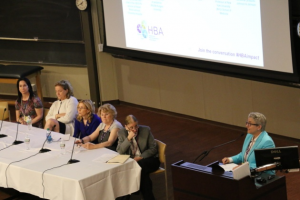 introductions by the event organizers as well as key leaders in healthcare. Susan Nicholson, the Vice President for safety surveillance and risk management at Johnson & Johnson, encouraged us to attend the day’s sessions with an eye for
introductions by the event organizers as well as key leaders in healthcare. Susan Nicholson, the Vice President for safety surveillance and risk management at Johnson & Johnson, encouraged us to attend the day’s sessions with an eye for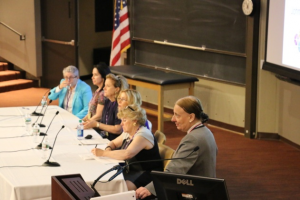 collaboration. She urged us to think, “How can I work with other people here and people in other disciplines to get things done?” This theme was directly in line with one of the day’s sessions, called Provider, Academia and Industry Collaboration. Christine Grant, the former New Jersey Commissioner of Health and Senior Services, challenged us to do three things throughout the day:
collaboration. She urged us to think, “How can I work with other people here and people in other disciplines to get things done?” This theme was directly in line with one of the day’s sessions, called Provider, Academia and Industry Collaboration. Christine Grant, the former New Jersey Commissioner of Health and Senior Services, challenged us to do three things throughout the day:
- To play a game, that boiled down to ignoring the need to constantly check our phones and to instead, learn from the people present at the event,
- To acquire, accept, adopt information and adapt (AAAA) accordingly based on lessons learned from the day’s sessions, and to
- To recognize threats unique to today’s society, such as “fake news” and the occasional overuse or misuse of technology.
Additional introductory remarks were made by Gloria Bachmann, MD, the director of the Women’s Health Institute at Robert Wood Johnson Medical School; Connie Newman, an endocrinologist at New York University School of Medicine and 2017-2018 president-elect of the American Medical Women’s Association; Annegret Dettwiler-Danspeckgruber, MS, ED, a neuroscientist at Princeton University; and Saralyn Mark, MD, a physician and owner-founder of SolaMed Solutions, LLC and iGIANT. Overall, this introductory session evoked the mindset that women can make change happen.
The introductory panel was followed by two breakout sessions (full program here). Each breakout had three options that attendees could participate in.
The options for the first session were:
- The Female Lifecycle
- Big Data, Artificial Intelligence and Wearables
- Harnessing Women’s Voices
The options for the second session were:
- Wellness vs. Disease Care,
- Provider, Academia and Industry Collaboration and
- New Science for High-Impact Change.
I attended The Female Lifecycle, followed by Wellness vs. Disease Care.
At The Female Lifecycle, there were panelists from HealthyWomen, Ichan School of Medicine at Mount Sinai, Monmouth Medical Center and the US Department of Labor, Women’s Bureau. The topics and panelist expertise ranged from fertility to women’s career advancement. A common theme during the session was how each of these topics relates to different points in women’s lives. For example, the panel discussed how to incorporate fertility into high school sexual education classes and how companies can support women in their careers while caring for a newborn child, a spouse, or an elderly relative. At this session, I also learned that the menstrual cycle is considered as a “5th vital sign”--in other words, it is an important indicator of female health. During the audience Q&A, I gained interesting insight on the topics of female body image and medical tourism, specifically why some individuals seek medical services outside of the United States.
For the second breakout session, I attended the panel discussion on Wellness vs. Disease Care, with representatives from the Robert Wood Johnson Foundation, Visiting Nursing Association of Central Jersey, Project ECHO Nevada and Medicines360. The panelists stressed how access to care and health outcomes can vary dramatically based on geographical location. This disparity is seen even across a few dozen miles as depicted in the life-expectancy graphic of New York City and Central New Jersey (pictured). In addition, some patients must 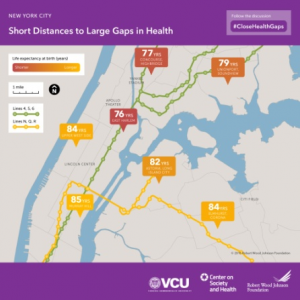 travel hundreds of miles for routine doctor’s appointments. Even within the same healthcare system, patients may be treated differently based on race, gender, and/or socioeconomic status. The goal of many of the companies that the panelists represented is to overcome these barriers in ways that promote a sense of community, shared learning, and overall wellness. We also discussed
travel hundreds of miles for routine doctor’s appointments. Even within the same healthcare system, patients may be treated differently based on race, gender, and/or socioeconomic status. The goal of many of the companies that the panelists represented is to overcome these barriers in ways that promote a sense of community, shared learning, and overall wellness. We also discussed 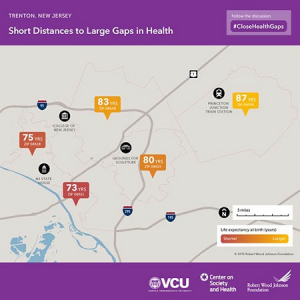 what barriers exist in today's healthcare system regarding the development of new, effective technologies and how we can bring them to market and help them thrive. The topics that were discussed demonstrated the true passion and drive that the panelists and members of the audience have for improving the lives of women and men in United States. The moderator, Jessica Grossman, MD and CEO of Medicines360, summarized the message of the session best when she said, “We’re not out there to get money. We’re out there to provide access”.
what barriers exist in today's healthcare system regarding the development of new, effective technologies and how we can bring them to market and help them thrive. The topics that were discussed demonstrated the true passion and drive that the panelists and members of the audience have for improving the lives of women and men in United States. The moderator, Jessica Grossman, MD and CEO of Medicines360, summarized the message of the session best when she said, “We’re not out there to get money. We’re out there to provide access”.
Although I was only able to attend two out of a total of six breakout sessions (2 groups of 3 concurrent sessions), I was able to learn about what was discussed in the other sessions through the summary breakout sessions at the end of the event. In addition to the content at the sessions, the WHILS conference included 19 educational posters and 12 exhibits from organizations that are impacting women’s healthcare in one way or another. Posters were presented by students and professionals alike and covered a broad range of topics. Exhibitors included: American Medical Women’s Association; American Lung Association; American Cancer Society; Cancer Care; NJ Department of Health; NJ Department of Labor; PharmaVOICE, various schools and programs within Rutgers; Sharecare; U.S. Department of Labor; and Well Spouse, an organization that facilitates peer support from individuals with spouses who are seriously ill; and, of course, HBA.
There was so much to see and experience that it was hard to cover everything, but overall, I was impressed by the scope of women’s health-related topics that were discussed and represented throughout the day. I was also inspired by the efforts and potential solutions that were brought to the table by many key leaders in the healthcare industry.
Also noteworthy, the event was catered with delicious food and drinks from start to finish. A light lunch and refreshments between the sessions provided a perfect opportunity to network and peruse the exhibits and poster presentations. After the closing remarks, hot food was served, complete with butcher and stir fry stations. There was also a wine and smoothie bar, completing the "happy hour" theme.
At the end of the event, we were able to network with fellow program attendees, which was my favorite part of the day. It was interesting to meet and speak with a wide variety of women working in healthcare, including fellow graduate students, medical students, physicians, regulatory affairs representatives, medical communications experts, bench scientists, and vice presidents of both biotechnology start-ups and large pharmaceutical companies. I was able to ask questions about the day-to-day schedules of these various professionals and learn about potential internship and employment opportunities at their companies. One thing that I realized was that the WHILS conference truly encompassed all the possible places where we as graduate students and post-docs can go upon completion of our iJOBs training.
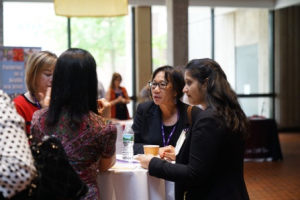 As a female graduate student in science, it was truly inspiring to be surrounded by successful women and men who work to push healthcare, science, and technologies in a direction that helps people all over the world. The event gave me a fr
As a female graduate student in science, it was truly inspiring to be surrounded by successful women and men who work to push healthcare, science, and technologies in a direction that helps people all over the world. The event gave me a fr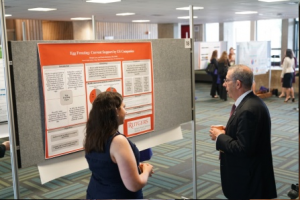 esh perspective and reminded me that the work that I do as a scientist can truly have an impact on the quality of peoples’ lives down the road. Thank you, HBA, for immersing me in this unique environment at the WHILS conference and inspiring me to evoke this message in the day-to-d
esh perspective and reminded me that the work that I do as a scientist can truly have an impact on the quality of peoples’ lives down the road. Thank you, HBA, for immersing me in this unique environment at the WHILS conference and inspiring me to evoke this message in the day-to-d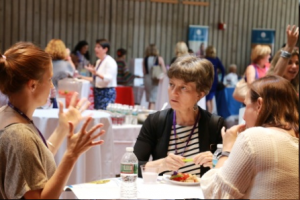 ay work that I do in the lab! I look forward to attending the next WHILS conference in 2019!
ay work that I do in the lab! I look forward to attending the next WHILS conference in 2019!
Thank you, as well, to all of the event sponsors and other contributors who made the WHILS conference possible, and who enriched the program content. I want to list the major in-kind and corporate sponsors, in particular, including in-kind founding sponsor Rutgers, The State University of New Jersey; Johnson & Johnson Innovation; in-kind supporters, American Medical Women’s Association and PharmaVOICE; platinum sponsors Regeneron and Sharecare; gold sponsors iJOBS and Quest Diagnostics; silver sponsors Boehringer Ingelheim and Medicines360, and bronze sponsor, Pfizer.